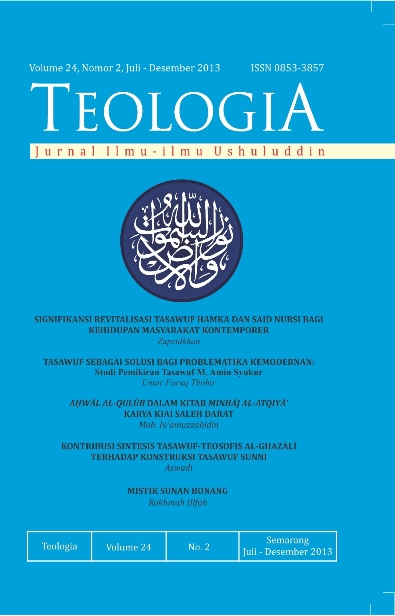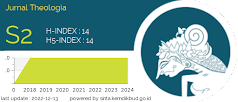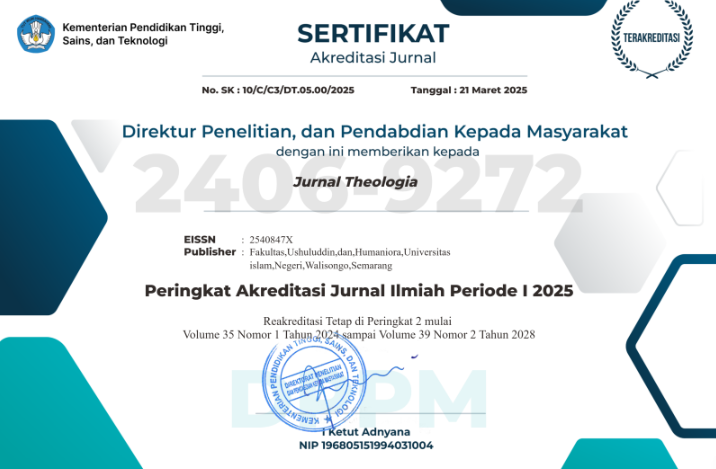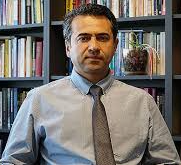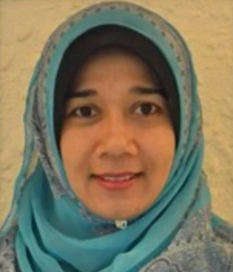AḤWᾹL AL-QULŪB DALAM KITAB MINHᾹJ AL-ATQIYᾹ’ KARYA KIAI SALEH DARAT
DOI:
https://doi.org/10.21580/teo.2013.24.2.328Abstract
Abstract: This article aims to elaborate the book of Kiai Saleh Darat’s Minhāj al-Atqiyā, a book of mysticism that is still used intraditional Islamic boarding schools (pesantren) in Java. The focus of the study is aḥwāl al-qulūb (conditions of heart spiritual), which is part of 'ilm al-mu'āmalah, the second science after the' ilmal-mukāsyafah, a device used for the science to the after life. Aḥwāl al-qulūb can be devided two dimension: commendable and despicable. The commend able is like patience, gratitude, fear, hope, willing, asceticism, piety, qanā'ah, sakhā' (generous), Husnal-zan, Husnal-khulūq, Husnal-mu'āsyarah, sidq, and Ikhlas. Mean while, the despicable is as scared indigent, hate destiny, jealousy, envy, looking sublime, happy and eternal praise in the world, arrogant, riya, covetous, griping, and others. By knowing which ahwalal-Qulub which are commendable and despicable, will facilitate the followers of Sufismactors (Salik) to go to the presence of God. In addition, this paper also will discover what it is contribution and relevance of Kiai Saleh Darat’s thought in modern era. Abstrak: Artikel ini bertujuan mengelaborasi kitab Minhāj al-Atqiyā’ Kai Saleh Darat, sebuah kitab tasawuf yang masih digunakan di pesantren-pesantren tradisional di Jawa.Fokus kajian adalah aḥwāl al-qulūb (kondisi spiritual hati) yang merupakan bagian dari ‘ilm al-mu‘āmalah, ilmu kedua setelah ‘ilm al-mukāsyafah, sebuah piranti ilmu yang digunakan untuk menuju akhirat. Aḥwāl al-qulūb itu sendiri ada yang terpuji dan ada yang tercela. Adapun yang terpuji adalah seperti ṣabar, syukūr, khauf, rajā’, riḍā, zuhūd, taqwā, qanā‘ah, sakhā’ (dermawan), ḥusn al-ẓan, ḥusn al-khulūq, ḥusn al-mu‘āsyarah, ṣidq, dan ikhlāṣ. Sedangkan aḥwāl al-qulūb yang tercela adalah seperti takut fakir, benci takdir, dengki, iri, mencari keluhuran, senang pujian dan kekal di dunia, takabur, riya, tamak, bakhil, dan lain-lain. Dengan mengetahui aḥwāl al-qulūb mana yang terpuji dan mana yang tercela, akan memudahkan pelaku pengamal tasawuf (sālik) sampai menuju ke hadirat Allah. Di samping itu, tulisan ini juga akan mengungkapkan seberapa jauh kontribusi dan relevansi pemikiran Kiai Saleh Darat tersebut di era modern saat ini. Keywords: Qanā‘ah, Zuhud, Tawakkal, Ikhlas, Sabar, Sakhā’, Ḥusn al-Khulq, ḥubb al-dunyā, riyā’, ‘ujūb, ḥasad.Downloads
References
Bruinessen, Martin van, Kitab Kuning, Pesantren dan Tarekat: Tradisi-tradisi Islam di Indonesia, Bandung: Mizan, 1415/1995.
Dimyāṭī, Sayyid Bakar al-Makkī ibn Muḥammad Syaṭā,Kifāyat al-Atqiyā’ wa Minhāj al-Aṣfiyā’, Semarang: Thoha Putra, t.th.
Ghazālī, Imām Muḥammad ibn Muḥammad Abū Ḥāmid, Iḥyā’ ‘Ulūm al-Dīn, Juz I, Singapura: Sulaymān Mara‘ī, t.th.
Ḥasan, ‘Abd Ḥakīm, al-Taṣawwuf fī Syi‘r al-‘Arab, Mesir: al-Anjalu al-Miṣriyah, 1954.
Ibn ‘Abbād al-Randī, Syarḥal-Ḥikam, juz I, Bandung: Syirkah al-Ma‘ārif, t.th.
Ibn ‘Ajībah, Īqāẓ al-Himam fī Syarḥ al-Ḥikam, taqdīm wa murāja‘ah: Muḥammad Aḥmad Ḥasab Allāh, Kairo: Dār al-Ma‘ārif, t.th.
Ibn ‘Aṭā’ Allāh, al-Tanwīr fī Isqāṭ al-Tadbīr, Bairut: al-Maktabah al-Sya‘baniyah, t.th.
Ibn ‘Aṭā’ Allāh, Laṭā’if al-Minan, ditaḥqīq oleh ‘Abd al-Ḥalīm Maḥmūd, Kairo: Dār al-Kutub, 1974.
Kalābāżī, al-Ta‘arruf li Mażhab Ahl al-Taṣawwuf, Cairo: Maktabah al-Kulliyah al-Azhariyah, 1969, h. 118-119.
Kartanegara, Mulyadhi, Menyelami Lubuk Tasawuf, Jakarta: Erlangga, 2009.
Ma‘lūf, Luwīs, al-Munjid fī al-Lughah, Bairut: al-Maṭba‘ah al-Kāṡūlaykah, t.th.
Masyharuddin, Ibn Taimiyah dan Pembaharuan Tasawuf, dalam Tasawuf dan Krisis, Yogyakarta: Pustaka Pelajar, 2001.
Munir, Ghazali, Shalat Jum’at Bergantian, Implementasi Konsep Iman dan Amal Muḥammad Salih Ibn Umar as-Samarani dalam Masyarakat Modern, Semarang: Syiar Media Publishing, 2008.
Munir, Ghazali, Tuhan, Manusia, dan Alam, dalam Pemikiran Kalam Muḥammad Salih as-Samarani, Semarang: Rasail, 2008.
Qusyairī, Abū al-Qāsim ‘Abd al-Karīm Ibn Hawāzin, al-Risālah al-Qusyayriyah, ditaḥqīq oleh Ma‘rūf Zurayq dan ‘Alī ‘Abd al-Ḥamīd Balṭahjī, Bairut: Dār al-Khair, t.th.
Salim, Abdullah, Majmū‘at al-Sharī‘ah al-Kāfiyah li al-‘Awwām karyaShaikh Muḥammad Ṣāliḥ ibn ‘Umar al-Samārānī, Disertasi, Jakarta : IAIN Syarif Hidayatullah, Fak. Pascasarjana, 1994.
Samārānī, Muḥammad Ṣāliḥ, Hażā al-Kitāb Matn al-Ḥikam li Sayyidī al-Syaikh Aḥmad ibn ‘Aṭā’ Allāh al-Sakandarī, Semarang: Thoha Putra, t.th.
Samārānī, Muḥammad Ṣāliḥ,Minhāj al-Atqiyā’ fī Sharḥ Ma‘rifat al-Ażkiyā’ ilā Ṭarīq al-Awliyā’ , Bombay: Muḥammad, 1317 H.
Shabir, Muslich, “Studi Kitab Munjiyat: Menyingkap Konsep Kiai Saleh Darat tentang Perbuatan yang Membinasakan dan yang Menyelamatkan Manusia,” Jurnal Walisongo, PUSLIT IAIN Walisongo, Vol. XV, Nomor 1 Mei 2007.
Shadaqah, KH. Ahmad Harits, Tauṣiyat al-Aṣfiyā’ fī Tarjamat Hidāyat al-Ażkiyā’, Semarang: Ma’had al-Tafsīr wa al-Sunnah, al-Itqān, t.th.
Syukur, M. Amin, Zuhud di Abad Modern, Yogyakarta: Pustaka Pelajar, 2000.
Taftāzānī, Abū al-Wafā al-Ghanīmī, Madkhal ilā al-Taṣawwuf al-Islāmī, Kairo: Dār al-Ṡaqāfah, 1979.

